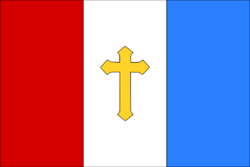Alvernia
Republic of Alvernia Alvernia | |
|---|---|
|
Flag | |
| Motto: "Divided, We Remain One" | |
| Status | Independent State |
| Capital and largest city | Soncinia |
| Official languages | Salvian, Aroman |
| Religion | Salvian Catholicism |
| Demonym(s) | Alvernian |
| Government | Unitary presidential republic |
• President | President Marco Marzeni |
| Legislature | House of Delegates |
| Establishment | |
| 505 BC | |
| 247 AD | |
| 605 AD | |
| 698 AD | |
| 1261 AD | |
| 1709 AD | |
| Area | |
• Total | 165,016 km2 (63,713 sq mi) |
| Population | |
• 2020 census | 9,234,678 |
• Density | 55.96/km2 (144.9/sq mi) |
| GDP (nominal) | estimate |
• Total | $144,181,027,614 |
• Per capita | $15,613 |
| HDI (2020) | .712 high |
| Currency | Salvian Croinare (SCR) |
| Time zone | UTC+2, +3 |
| Date format | dd/mm/yyyy |
| Driving side | right |
| Calling code | +247 |
| Internet TLD | .alv |
Alvernia, officially known as the Republic of Alvernia, was a unitary presidential republic on the island of Tenarua in Marenesia Major. It was divided into 6 administrative regions and covered an area of 165,016 square kilometres (63,713 square miles). With a population of 9.2 million, it was the fourth largest nation in Marenesia until its incorporation into the Catholic Republic of Salvia as the region of Alvernia. It is bordered on the north by the Alvernian Highlands, the east by Salvia and the south and west by the Adlantic Ocean.
Human activity in Alvernia begins 50 thousand years ago with the arrival of modern humans, who crossed the South Oriental Ocean and numerous land bridges to arrive on the continent. Evidence of agriculture and settlement is first found in the 5th millenia BC, shortly after similar evidence appears on the Salvian peninsula. Various cultures and tribes inhabited the region, although the most distinct was the Alva, who also gave the nation its name. It's dominance would come to an end in the 8th century BC following its subjugation by the Friulian Kingdom, which would become the First Salvian Imperium. Cultural hegemony was enforced unsuccessfully throughout the Classical period, with the Alvernian region maintaining their own distinct culture. The arrival of Aroman migrants in the Great Aroman Migration led to the collapse of the First Imperium and the rise of the Second and Third Salvian Imperium, with Alvernia remaining under Salvian rule. While some cultural unity took place between the two regions, Alvernia remained a distinct region and so declared its own kingdom following the collapse of the Third Imperium, forming the Kingdom of Alvernia. The kingdom would be divided in the 11th century by rival powers and northern Marenai tribes, and the territory as a whole would be subjugated by the Divine Imperium of Salvia. Catholics and ethnic Salvians would migrate to Alvernia en masse in the 14th century, replacing the pagan and Marenai majority and inciting tensions between the different groups which would result in the destructive Salvian Wars of Religion. Despite cultural hegemony appearing over a shared Salvian heritage, divisions between Alvernia and the peninsula remained throughout the Divine Imperium's reign over the region and independence movements would pop up throughout the 16th and 17th centuries. Independence from Salvia would be declared during the People’s War and Alvernian independence was recognized by the newly created Divine Republic.
Inspired by Enlightenment thinkers from the People's War such as Carlo Razini and Leo Angelo, the nation's first presidents, known as The Champions, instituted democratic reforms that transitioned the region to a republic. Several border conflicts were fight with the Salvians with Alvernian success, gaining territory and demonstrating Alvernian dominance over Salvia which would last for the rest of the 18th century. Plentiful natural resources and a stable government allowed for the Industrial Revolution in Alvernia during the mid 19th century, leading to an economic boom, a rise in living standards, and a wave of liberalism which inspired reform. Despite these improvements, the period also oversaw Alvernia overshadowed by its Salvian counterpart. Throughout the 20th century, economic and political cooperation with Salvia resulted in the two being cosignatories to the Tenaruan Continental Accords. Siding with Limonaia in the Great Alharun War, Alvernia suffered great economic and civil strife after their defeat and the subsequent oil crisis. Following several politic crises, nationalist president Marco Marzeni would become president in 2005 and has since amended the Constitution of Alvernia to essentially guarantee him rule for life.
Alvernia is considered by most to be a developing region, with an economy ranking $$ in the wurld when separated from Salvia. The region suffers high poverty rates and corruption, but is the fourth largest manufacturer in Marenesia. The country is defined by the Constitution as a unitary semi-presidential republic, however the democratic nature of Alvernia is often questioned. Alvernia was a member of the Tenaruan Continental Alliance, $$$, and $$$. The nation has several cultural sites protected by the $$$ and is noted for its historical and cultural legacy as well as its natural beauty.
